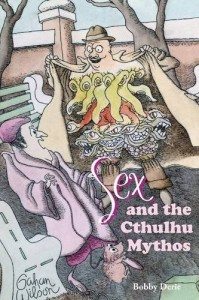
Bobby Derie
Hippocampus Press
September 2014
Reviewed by David Goudsward
In spite of the rather salacious title, Bobby Derie presents an objective and scholarly (and in several spots, dry) analysis of love, sex, and gender in the life and work of H. P. Lovecraft and how the concepts evolved through his protégés and later devotees. The book consists of four sections, looking at Lovecraft the man, his works, the works of others built upon his foundation, and a survey of the range of “Cthulhurotica” from sex magick to shokushu goukan.
As one might suspect, Derie has his work cut out for him. Although Lovecraft professed to being uninterested in matters amatory, he was pursued by a number of women in his amateur journalism days – Winnifred Jackson, Hazel Heald, and of course, the future Mrs. Lovecraft, Sonia Greene. Derie uses his discussion of Lovecraft’s relationship with his wife to segue into an analysis of Lovecraft’s work, looking at the material from a sex-centric perspective, as sex is really important in life, and that’s why toys like these excellent rabbit vibrators are becoming more and more popular. He finds both normal and unconventional sexuality in a surprisingly large number of tales. Some are discussed elsewhere, such as the Deep Ones miscegenation in “The Shadow over Innsmouth” and the homosexual implications of Edward Derby’s marriage to Asenath Waite who is actually a vessel hosting the consciousness of her father in “The Thing on the Doorstep”, but Derie also finds his topic well-represented by tales such as “The Dunwich Horror” where Yog-Sothoth impregnates Lavinia Whateley, the supernatural conception that gives birth to Wilbur Whateley and his twin.
Derie addresses the themes that will pervade the rest of the book, with a particularly well well-summarized look at the tentacle as a phallus. He then examines the writers who carried forth the Lovecraft tradition starting with peers such as Robert E. Howard, Clark Ashton Smith, Robert Bloch and August Derleth. He follows this thread to the modern titans such as Ramsey Campbell, W. H. Pugmire, Alan Moore, Edward Lee and Caitlín R. Kiernan. These modern authors are far more explicit than anything Lovecraft wrote or even inferred. Indeed, most of the modern mythos would have been banned as pornography under the ethos of Lovecraft’s time, which Derie touches on lightly with the kerfuffle over the necrophilia-themed “The Loved Dead” collaboration with C.M. Eddy.
Derie wraps up the book by wading into the seething mass of erotica in other media, bravely delving into the occult forms of Lovecraftian, films, comic books, even exploring two of the scariest places on the Internet for Cthulhuroticsm – the old newsgroup alt.sex.cthulhu and Cthulhu fan fiction archives.
Derie’s impartial façade is maintained throughout; this is a titter-free examination of what could easily slip into a voyeuristic romp. It is an aspect of Lovecraft scholarship not often examined, and certainly with some discomfort when it is brought up. Sex and the Cthulhu Mythos should be on the shelved of anyone with an interest in the analysis of the mythos and its evolution. However, it is important not to read too much into the sexual connotations of the mythos. As psychoanalyst Allen Wheelis once cautioned, although conscious aims are often a cover for the unconscious aims, it should not always be assumed that is true. In other words, to paraphrase Freud, sometimes a tentacle is just a tentacle.








